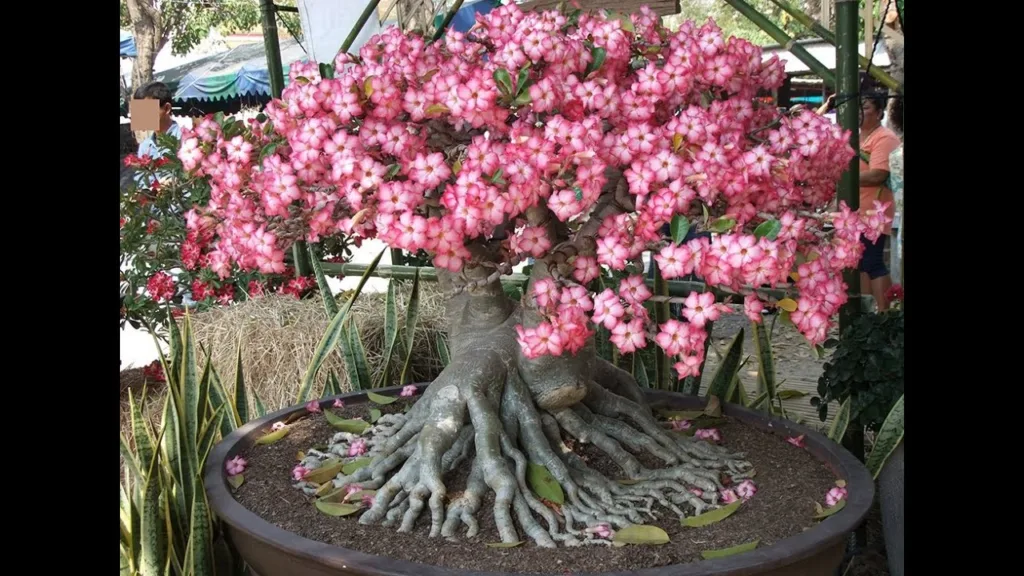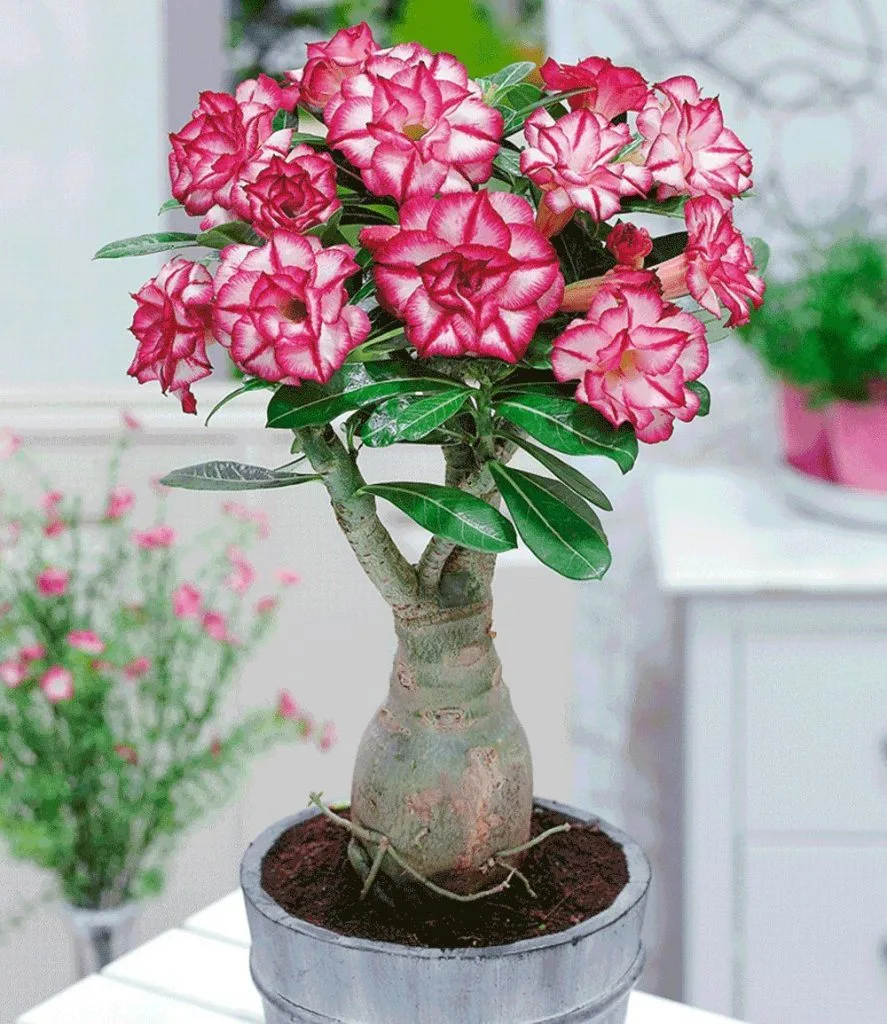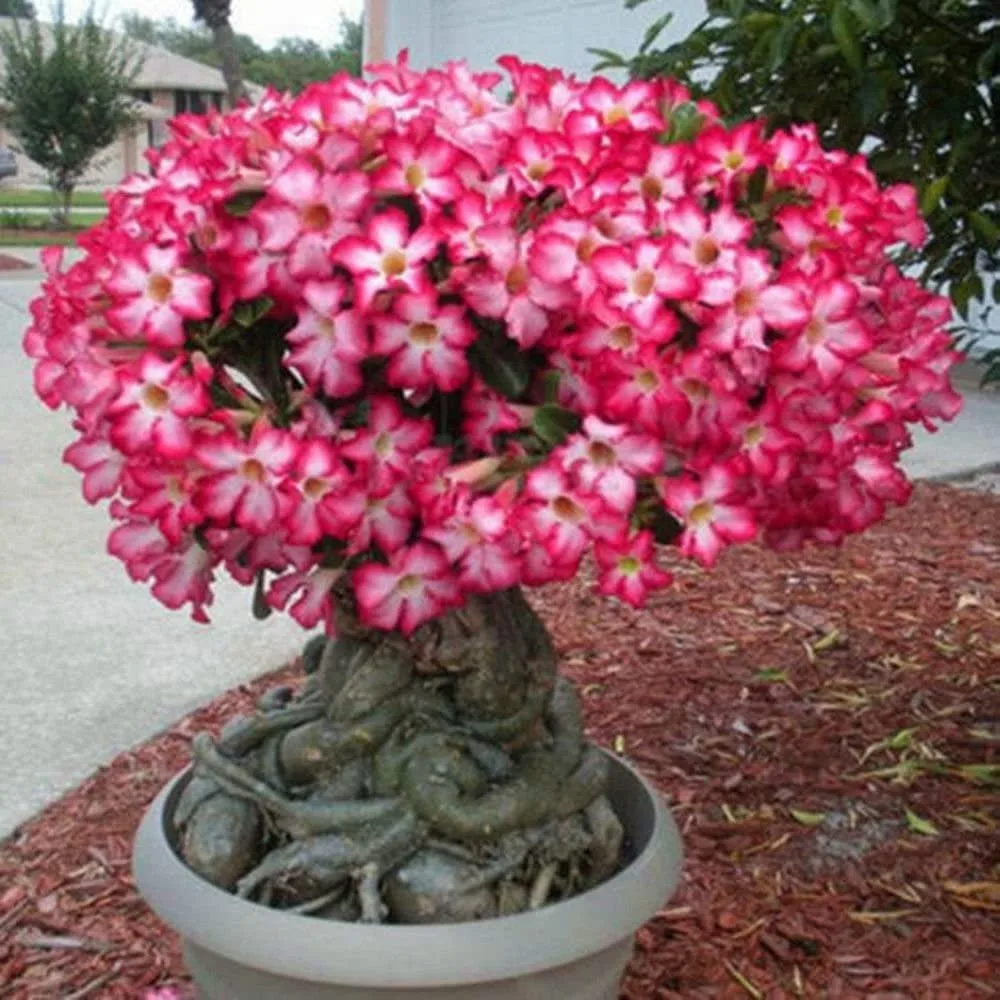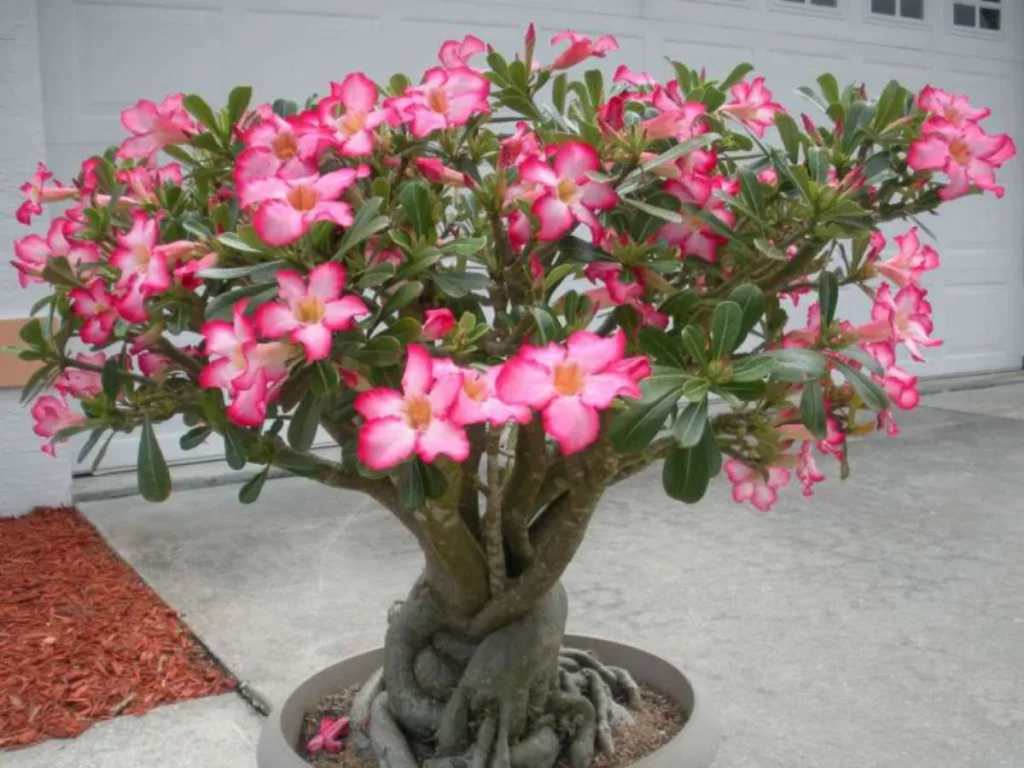Index
Introduction
Adenium obesum, commonly known as Desert Rose, is a succulent plant native to the arid regions of Africa and the Arabian Peninsula. This exotic plant is appreciated not only for its unique beauty, but also for its ability to thrive in arid, low-maintenance conditions. Its distinctive features include a thick, sculpted trunk, succulent leaves and vibrant flowers that can vary from shades of pink to red and even white.
Meaning of Adenium obesum
Adenium obesum has significant cultural importance in many regions where it is found. As well as being appreciated as an ornamental plant in gardens and plant collections, the Desert Rose is often associated with symbols of resistance, resilience and beauty in the midst of adversity. Its ability to thrive in arid conditions inspires admirers to see beyond difficulties and find beauty and vitality even in the most hostile environments.
| Common Name | Adenium obesum |
|---|---|
| Botanical Name | Adenium obesum |
| Family | Apocynaceae |
| Plant Type | Succulent |
| Adult Size | Variable, up to 2 meters high |
| Sun exposure | Full sun |
| Soil type | Well-drained, sandy |
| soil pH | Neutral to slightly acidic |
| Flowering Season | Spring to summer |
| Flower color | Varies (pink, red, white) |
| Native Area | Africa and Arabian Peninsula |
| Toxicity | Slightly toxic, be careful if swallowed |

How to care for Adenium obesum
When it comes to caring for Adenium obesum, also known as Desert Rose, it’s important to pay attention to several aspects to ensure its well-being and healthy development.
Light
Direct sunlight is essential for the healthy growth of the Desert Rose. Place it in a spot where it receives at least 6 hours of direct sunlight a day, preferably in the morning or afternoon.
Soil
The soil for Adenium obesum should be well-drained to avoid water accumulating around the roots. A mixture of sand, perlite and organic matter may be ideal to promote proper drainage.
Water
Although it is a succulent plant, the Desert Rose needs regular water during the active growth period in spring and summer. However, it is important to let the soil dry out between waterings to avoid root rot.
Temperature and humidity
This plant thrives in hot, dry climates, preferring temperatures between 25°C and 35°C during the day and no less than 15°C at night. Air humidity is not a critical factor, but avoid very humid environments to prevent fungal diseases.
Fertilizing
During the active growing season, which occurs in spring and summer, you can fertilize every two weeks with a balanced fertilizer, diluted by half. During the dormant period in autumn and winter, reduce fertilizing to once a month or stop it altogether.
By following these care tips, you can enjoy a healthy and lush Desert Rose in your garden or indoor space.

How to make Adenium obesum cuttings
If you want to propagate new Adenium obesum plants, the process of making cuttings can be an interesting and rewarding option.
Choice of material:
To make an Adenium obesum seedling, choose a healthy and vigorous mother plant. Look for a side branch that is at least 10 centimeters long and has 2-3 healthy leaves.
Preparing the cutting:
Cut the cutting using a sharp, sterilized blade to avoid infection. Make sure the cut is clean and made at a 45-degree angle to increase the area for absorbing water and nutrients.
Rooting the cutting:
Let the freshly cut cutting dry out in the open air for a few days to form a protective bark at the end of the cutting. Then plant the cutting in a well-drained substrate, such as a mixture of sand and perlite.
Care during rooting:
Place the cutting in a location with partial shade and keep the substrate slightly damp, but not soaked. Avoid overwatering to prevent the roots from rotting.

How to plant Adenium obesum
Once the roots have developed, which can take a few weeks, you can transplant the seedling into a larger pot or directly into the garden. Make sure you provide adequate sunlight conditions and continue the care as described in the previous section.
With patience and proper care, your Adenium obesum seedlings will grow and thrive, adding beauty to your green space.
Most common pests and diseases
When growing Adenium obesum, it’s important to be aware of the most common pests and diseases that can affect the plant’s health. Here is a list of the most common:
- Mites: Small insects that feed on the sap of the leaves, causing yellowing and drooping.
- Mealybugs: Insects that attach themselves to leaves and stems, sucking the sap and leaving a sticky secretion.
- Aphids: Small insects that feed on plant sap, causing deformities in the leaves.
- Root rot: Caused by excess moisture in the soil, resulting in root rot.
- Fungi: Can cause leaf spots, stem and flower rot, especially in conditions of high humidity.

Common Problems and Their Solutions
Mites, mealybugs and aphids:
- Solution: Wash the plant with running water to remove the insects. For serious infestations, use a specific insecticide, following the manufacturer’s instructions.
Root rot:
- Solution: Remove the plant from the soil, remove the affected parts and replant in a well-drained substrate. Avoid overwatering and allow the soil to dry out between waterings.
Fungus:
- Solution: Remove the affected parts of the plant and apply a suitable fungicide. Keep the plant in a well-ventilated area and avoid wetting the leaves when watering.
When you identify any problems with your Adenium obesum, it is important to act quickly to avoid serious damage to the plant. Regularly monitoring the plant’s health and providing suitable growing conditions will help prevent future problems.
Curiosities and myths
When it comes to the fascinating Adenium obesum, also known as the Desert Rose, there are many interesting curiosities and myths surrounding this exotic plant. Let’s explore some of them:
Curiosities:
- Natural Bonsai: Adenium obesum is often cultivated as a type of natural bonsai due to its ability to develop a thick, sculpted trunk over time.
- Water Storage: The Desert Rose’s succulent leaves act as water reservoirs, allowing the plant to survive in arid conditions for long periods.
- Vivid Flowers: The flowers of the Adenium obesum can remain showy for weeks on end, adding beauty and color to the environment.
Myths:
- Deadly Poison: A common myth is that all parts of the plant are highly poisonous. In reality, although the milky sap can cause irritation to the skin and mucous membranes, the toxicity of the Desert Rose is considered mild and rarely causes serious damage.
- Extreme Pruning Needed: Some people believe that the Desert Rose needs to be pruned drastically to maintain its compact shape. In fact, moderate pruning is usually enough to promote healthy growth and an attractive appearance.
- Origin of the name: There is a myth that the name “Desert Rose” refers to a legend which says that the flowers of the Adenium obesum bloom only once every hundred years in the desert. However, this is only a fictitious story and the flowers can bloom several times a year, under the right care conditions.
By exploring the curiosities and unraveling the myths surrounding Adenium obesum, we can further appreciate the beauty and uniqueness of this fascinating plant.

Conclusion
Throughout this article, we have explored several fascinating aspects related to Adenium obesum, popularly known as the Desert Rose. From its unique characteristics to the essential care required for its cultivation, we’ve learned that this succulent plant is much more than just a beautiful addition to a garden or indoor space. We discovered that, in addition to its exotic appearance and vibrant flowers, the Desert Rose is a resilient plant, capable of thriving in arid and challenging conditions, making it a symbol of strength and beauty in the midst of adversity.
It’s important to remember the main points highlighted throughout the article: the need for direct sunlight, well-drained soil, moderate watering and care for common pests and diseases. In addition, we have debunked some misconceptions about its toxicity and the origin of its name. With this information in mind, we can grow and appreciate the Desert Rose with more confidence and understanding, enjoying its unique beauty and adding an exotic and elegant touch to our green surroundings.
Frequently Asked Questions
What does the Adenium obesum like?
Adenium obesum likes direct sunlight and well-drained soils. It prefers hot, dry climates and requires moderate watering during the active growing season in spring and summer.
What does Adenium obesum mean?
The meaning of Adenium obesum, better known as desert rose, is associated with its origin and unique characteristics. “Adenium” refers to the botanical genus of the plant, while “obesum” means “obese” in Latin, alluding to the plant’s thick, succulent trunk.
How to care for Adenium obesum?
To care for Adenium obesum, it is essential to provide it with direct sunlight, well-drained soil and moderate watering. In addition, it is important to avoid excess humidity, protect it from extreme temperatures and provide adequate fertilization during the period of active growth. Regularly monitoring the plant for signs of pests, diseases or other problems is also crucial to keeping it healthy and lush.







